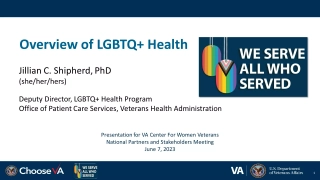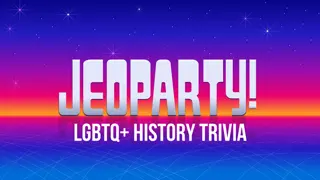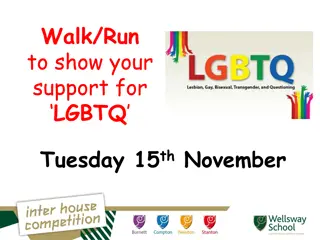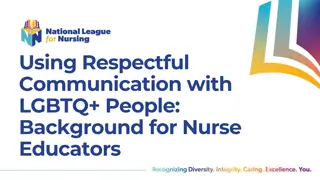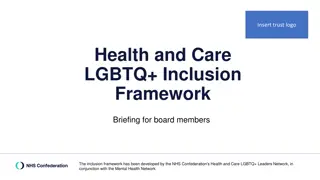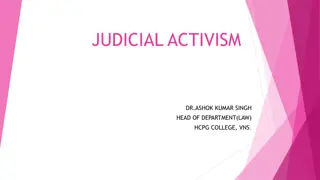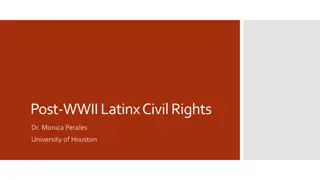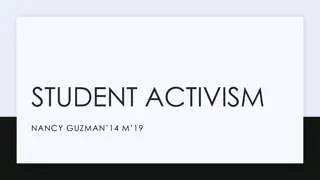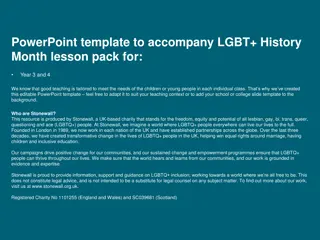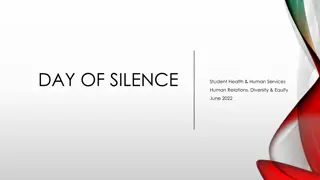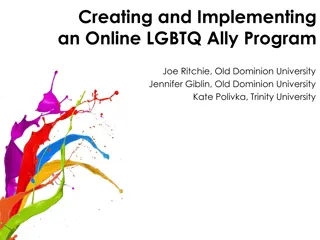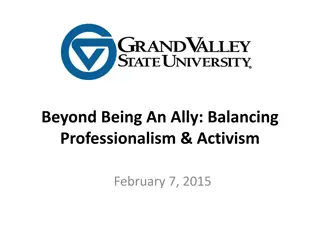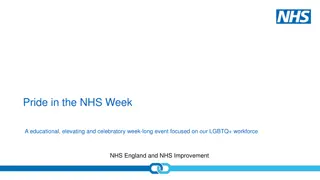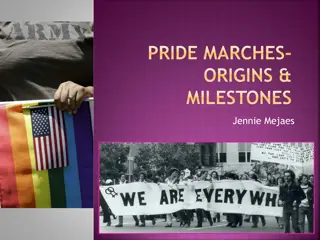LGBTQ Rights and Activism: A Historical Perspective
Alan Turing's contributions to computer science, his tragic experience as a homosexual in the 20th century, definitions of sexual orientation and gender identities, and the timeline of LGBTQ rights and setbacks in the US are discussed. The narrative highlights the struggles and progress made in advocating for LGBTQ+ rights and acceptance.
Download Presentation

Please find below an Image/Link to download the presentation.
The content on the website is provided AS IS for your information and personal use only. It may not be sold, licensed, or shared on other websites without obtaining consent from the author. Download presentation by click this link. If you encounter any issues during the download, it is possible that the publisher has removed the file from their server.
E N D
Presentation Transcript
Alan Turing (1912-1954) Turing (1936) formalized the idea of effective procedure which led to the theory of computation, which is the foundation of computer science. Helped develop a code-breaking system for a German cypher machine called Enigma during WW II, deciphering approximately 2 messages every minute, day and night. His design for the Automatic Computing Engine (ACE) was the first complete specification of a stored program computer. He laid foundations to both Artificial Intelligence and Cognitive Science with his classic paper on Computing Machinery and Intelligence (1950). 2
The Tragedy of Turing Turing was also homosexual, which was a crime in 20 th century England. In 1952, he was convicted of gross indecency and sentenced to 12 months of therapy. The same year, he published The chemical basis of Morphogenesis, his most cited paper! Turing died of cyanide poisoning in 1954, most likely killing himself. He was granted royal pardon in 2013 by the queen 3
Definitions Sexual orientation Homosexual: attracted to the same sex/gender as the individual Lesbian: Homosexual woman Gay: Homosexual man Heterosexual: attracted to the opposite sex or gender Bisexual: attracted to both sexes or genders Gender identity Transgender: Gender identity is different from sex Cisgender: Gender identity aligns with sex Queer: An umbrella term for genders and orientations that do not easily fit into any of the other categories (reclamation of a derogatory term), non-binary, gender-fluid 4
LGBTQ Rights in the US Henry Gerber, a German immigrant in Chicago founded the Society of Human Rights, the first gay rights organization in 1924. In 1948, in his book Sexual Behavior in the Human Male, Alfred Kinsey proposed that male sexual orientation lies on a continuum between homosexual to heterosexual. In 1952, Dale Jennings formed an organization called One Inc, and published the first pro-gay magazine. One Inc. won a law-suit against the post office in 1958 for refusing to deliver their magazine. The second gay rights magazine, The Mattachine Review, andthe first lesbian magazine, The Ladder, startedin 1955. 5
Setbacks (1950s and 60s) In 1952, American Psychological Society declared homosexuality a form of mental disorder. In 1953, president Dwight Eisenhover banned gays from federal jobs. Most states barred homosexual activities Gay bars became the places of refuge Police cracked down on gay and lesbian bars Bartenders deny drinks to people who are suspected of being gay 6
The Mattachine Society In 1966, the Mettachine society staged a sip in and were denied drinks in Greenwich village. The resulting uproar led to a reversal of anti-gay liquor laws. Engaging in sexual activities was still illegal, and the bars continued to be raided. Crime families like Genovese family took over most gay bars in the Greenwich village. Stonewall inn was one of them. The Mafia paid the police to keep away while they served illegal alcohol. 7
Stonewall Protest In 1969 Stonewall Inn was raided by police, this time without being tipped off beforehand. The raid sparked a riot and 6 days of protests and clashes with police. Became a catalyst for gay rights movement. Many new organizations emerged: Gay liberation front, Gay Activists Alliance, Radicalesbians, and Street Transvestites Action Revolutionaries Stonewall Inn was declared a national monument by Obama in 2016. 8
LGBT Victories In 1977, US Supreme court ruled that the first transgender woman Renee Richards can play tennis in US open as a won Many LGBT people were elected to public offices, including Harvey Milk who became the San Francisco city manager in 1978. The rainbow flag, designed by Gilbert Baker, was unveiled in San Francisco pride parade in 1978 and became a symbol of LGBT rights. 100,000 people participated in March on Washington in 1979. 9
Outbreak of AIDS In 1981, AIDS reached the United States Researchers identified the HIV as the cause of AIDS in 1984, first blood test in 1985. Antiretroviral drug AZT was available in 1987 Hospitals could deny gay partners to use their insurance. Family and probate courts, adoption agencies and funeral homes treated gay partners as strangers. About 100,000 people had AIDS by the end of the decade in the US 10
DADT and DOMA In 1992, Washington DC passed domestic partners law. California did so in 1999. Clinton signed the Don t Ask Don t Tell (DADT) law in 1993 to allow gays and lesbians to serve in military, but only if they hide their identity. In 1993, Hawaii s courts ruled that ban on same-sex marriage may violate the constitution. Congress passed and Clinton signed Defense of Marriage Act (DOMA) in 1996. In 1998, Hawaii s voters banned same-sex marriage. 11
Hate-crime laws and marriage laws In 1994, a hate-crimes law was passed to protect LGBT people. In 2003, the Supreme court struck down the last anti-sodomy laws (inc. Texas). (Oregon s law was struck down in 1971.) In 2009, Obama signed a hate- crimes law in response to a 1998 murder of a university of Wyoming student Mathew Shepard. In 2011, he repealed DADT. 12,000 officers were discharged under the law. In 2015, the supreme court ruled that states cannot ban same-sex marriages in Obergefell vs. Hodges. 12
Transgender Peoples Rights In 2015, Boy Scouts of America lifted its ban against openly gay leaders and employees In 2017 lifted a ban against transgender boys In 2016 US military lifted a ban against transgender people serving openly 13
Unfinished Work In 2017 Trump reinstated the ban against transgender people in military The plan to count LGBTQ people in the 2020 census was revoked Universal work place and anti-discrimination policies are still lacking Many state laws allow religious exceptions to LGBTQ rights Bathroom laws prohibit transgender people from using public restrooms of their choice 14
Discussion Topics Why is there so much resistance to let people be who they are? What changed the public opinion on issues? What did you notice about the rate of change? What lessons can we draw for other social movements? 15
Take Away Messages A lot of human tragedy is due to unequal distribution of power, fear of the unknown, and lack of empathy towards people different from us. It takes a long struggle to change peoples minds. Frequent setbacks are common. Political activism, persistence and hard work by dozens of rights organizations were the keys for changes in the public opinion. The arc of moral universe is long, but it bends towards justice. Martin Luther King Jr. Technology, when properly used, can be an accelerator and force multiplier for social good. 16




